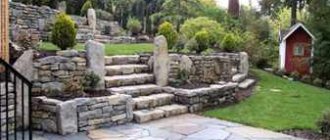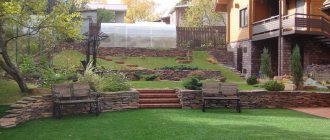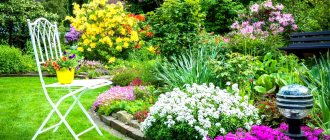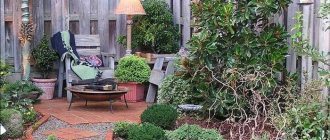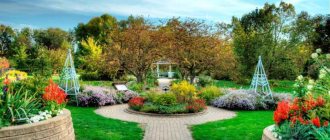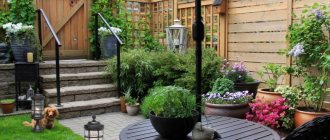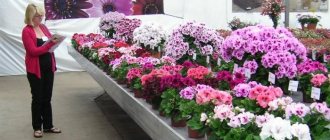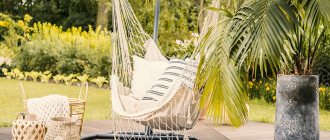“Time is on our side: the garden can become low-maintenance, we just need to give it time to grow, and we’ll have to do a little weeding at first,” write experienced FORUMHOUSE gardeners to beginners who are taking their first steps in arranging a “lazy plot.” After a couple of years, it becomes clear that time really works on the gardener’s side. Simple landscape design, correctly selected plants, competent agricultural techniques such as mulching do their job, and the owner relaxes in the garden more than he works. In this article we will tell you how to create a real low-maintenance garden, what plants to plant, what rules to follow and what mistakes to avoid. “Is it even possible – a beautiful garden that requires virtually no maintenance? - beginner gardeners ask. “Isn’t this a myth?” No, not a myth. Proven by agronomic science and FORUMHOUSE participants.
Garden, decorative all year round Catching the “new wave” Low-maintenance garden on a small plot Plants for a low-maintenance garden
Beauty or functionality
Various photos of the design of a small plot mainly demonstrate the beauty of the landscape. However, in addition to attractive vegetation, an open-air place may have:
- Relaxation structures - gazebo, benches, swings;
- Miniature vegetable garden;
- Garden trees and shrubs;
- Economic objects - garage, utility block, greenhouse, chicken coop, rabbitry, etc.
Typically, about 10% of the site is occupied by a residential building, and the same amount of space is dedicated to walking paths.
The remaining area must be distributed so that beauty and functionality are in harmony with each other. To take into account this requirement, some temptations will have to be abandoned.
For example, living creatures make a lot of noise, so a small area is suitable for household needs only for good reasons. The same goes for the workshop. The garage is another matter, because... personal transport periodically has to be put in order, even at a basic level.
Also, thanks to the garage, you can abandon the utility unit. However, when every square meter is at stake, then many other objects have to be blacklisted.
Elements of a small garden and planning lines
Intricately shaped garden paths and planning lines look interesting on fairly large areas, but on a small garden plot there is no point in making bends and numerous turns. If you don’t like straight lines, then follow the path of compromise - use circles and arcs of varying sizes. The smooth waves of mixed borders, lawns, flower beds and areas with decorative backfill look especially impressive. Their shape can either narrow or expand, making the space more picturesque.
Conditional taboo
A small plot is not a death sentence, but an opportunity to bring fresh ideas into reality. The main thing is that the appropriate techniques are not accompanied by banal mistakes that visually make the landscape design of a small area dark and cluttered:
- Firstly, it is recommended to minimize the number of external buildings (gazebo, utility block, barn, chicken coop);
- Secondly, a high solid fence contributes to cramped conditions and isolation, so instead of it it is better to build a traditional fence with through openings;
- Thirdly, tall trees (oak, pine, walnut) clutter and shade the space, making them unsuitable for landscaping a small area.
Conditionally problematic objects should not be immediately blacklisted. Here it is important to decide on priorities: what is better - a gazebo or a utility block, a fragrant pine tree or a fruit-bearing nut?
The trees can be young (not tall), and the structure can be small, mobile and even collapsible. The main thing is that there are few objects themselves, and that they are relevant.
Take advantage of the terrain
If there is at least a slight difference in height on your tiny plot, then this should definitely be used to give greater depth and expressiveness to the design of a small garden.
If you are the “lucky” owner of a flat space, then it doesn’t matter! Take advantage of the possibilities of geoplasticity; to do this, it is enough to arrange several raised flower beds or stationary flower beds, and ideally, arrange small terraces. This is not as expensive as it seems at first glance, given the small size of your property, but the effect of the transformation will completely change the garden, and at the same time your view of the art of landscape design. Adhere to the following rules:
— When changing the terrain, do not create hills and slides on the site - in such small areas, these design elements are more likely to suppress the space than to expand it.
— The lines of the terraces along which the retaining walls will be located should not be straight, but rather sharp broken or smoothly curved. In addition, under no circumstances should they divide the site in half.
— Slightly “sunk” gardens or areas, as well as terraces built in the form of an amphitheater, distract attention from the boundaries of the garden and visually enlarge it.
— If it is impossible to artificially change the topography, try making decks and platforms of different heights, which can give the garden vertical dynamics.
Simple site geometry
Even inside an open and bright area, you can experience some visual discomfort. Moreover, the latter is often facilitated not so much by color contrast as by complex geometry:
- Structures with sharp corners;
- Plant density;
- Style difference between objects.
It is unlikely that grapes will suit a pagoda gazebo, or a dry pond will suit a stone rotunda. The corresponding example should be folded in reverse so that the overall style is maintained within a small area.
It is clear that sometimes it is not possible to abandon traditional designs in favor of rounded analogues. Therefore, the layout of a small area with rectilinear objects welcomes miniature pots and flower pots.
Such containers are convenient to transport, modifying the façade depending on the time of year and other factors. The facade itself ceases to seem strict, because... flora looks away from sharp and right angles.
Vertical gardening techniques
Of course, a garden cannot be greened with just one, albeit large, tree. Not only the right choice of plants, but also a competently applied planting method will help turn it into a lush flowering corner.
Recent Entries
Lilac perennials that are beautiful, compact and do not crowd out other plants Why when buying seedlings you should not take the sellers’ word for it and how to determine the age of the plant using 3 signs Tomato seedlings have turned purple or whitish: why the color has changed and how to save the plants
The vertical method of gardening is especially important for a modest-sized plot. To make walls of greenery, arches, garden trellises, fences, pergolas, facades and gazebo fences are used. Screens and trellises are the most common decorative elements when arranging mini gardens. They are used both as independent elements and in combination with flowerpots, flower beds and various garden accessories. They are also used to delimit individual zones of the site.
When using vertical gardening, it is very important to carefully select plants for this purpose, because hops, for example, can fill the entire area
Various varieties of wild grapes, decorative beans, hops, sweet peas, and clematis are suitable as plants for vertical gardening. In order for all this wealth to be abundantly covered with greenery and flowers, many factors must be taken into account when planting: the condition of the soil, the amount of precipitation, shading, the prevailing wind direction and other features inherent in your site.
By the way, not only garden plants, but also garden plants can be used as greenery. Very interesting vertical gardens are created using plastic bottles. To avoid monotony in perception, it is better to use different plants.
A bench in flowers is a popular design technique for expanding space, which leaves a lasting impression on the viewer who sits on such a bench
Place an ordinary bench near the fence and build a tall flowering arch entwined with roses directly above it. If you now sit down on this bench, you will have the complete feeling that a spacious garden extends around you, in the depths of which you are located. Techniques for creating a wild and slightly neglected garden are always effective in areas where space is limited.
The lush greenery and mats surrounding the garden space create the illusion that your area is surrounded on all sides by a real jungle
Planting is best done according to the cascade principle, when small plants in flower pots are placed in the foreground. The size of the plants increases gradually. Tall flowers, bushes and small trees can be placed in flowerpots or even barrels. With the help of a cascading design, it is easy to create the effect where the viewer's gaze slides upward diagonally. A similar result can be achieved if you use vertical gardens.
Vases with flowers allow you not only to create amazing compositions, but also to change them as often as the author wants
Why did we mention flowerpots? Because placing plants in them allows you to change the design of the site, simply rearranging them over the course of even one season exactly as we currently want.
Another unusual idea that is rarely implemented here: you can find a wonderful place for picturesque landscaping directly on the roof of garden buildings. This method allows you to simultaneously solve two problems. Firstly, a new area for planting is created, and, secondly, excellent additional thermal insulation of the roof is provided. Even in hot weather, the room will remain cool. Finally, it's simply beautiful!
Such an outbuilding with grass on the roof looks simply fabulous. Of course, it won’t suit every style, but the idea is not bad
Common Styles
Stone or wood, pine needles or larch, water pond or dry stream - sometimes you have to consider different styles to select a specific decorative object. This approach is correct, because commonality contributes to comfortable perception and convenient operation.
Now about the styles themselves:
- Classical. Organization begins from the center of the site, where the focal point is located. This focal point is often a gazebo, sculpture, fountain or tree. One or two paths extend from the center. The lawn is neat and trimmed.
- Forest. The style is relevant for areas located on slopes or adjacent to forests. One stream and two or three trees of different heights in different places (but at the same distance from each other) are welcome. The deficiency of trees can be compensated by a group of bushes, as well as wooden structures.
- Eco style. Here it is important to combine flora with artificial objects of unusual shape. The latter indicate modernity, the former emphasize nature. As a striking example of an eco-landscape, you can consider a glass domed gazebo among neat bushes and palm trees.
- Country. In the ethnic direction, there are several American mini-gardens, one mature tree, wicker or wooden furniture, a colorful flower bed, and a stone path. The focal point of attraction can be a scarecrow or a well.
- Mediterranean. In the southern European landscape, berries and flowers coexist with each other. Palm plants are also welcome. The stone rotunda gazebo along with the pond personify the Olympic flame and the elements of Odysseus, respectively.
- Alpine. In Scandinavian countries, it is customary to pay attention to stone and pine needles. The terrain goes without fences, which awakens a feeling of freedom. Figures in the form of gnomes, mushrooms and pointed flowers are frequent companions of Scandinavian folklore.
- Minimalism. Here the contrast is observed due to different shades of the same color and geometric shapes. Round stone balls can pass the baton to straight paths. It is better to avoid bright and colorful flower beds. But there can be many objects of regular geometry, provided that they are correctly distributed and do not occupy a lot of area.
The target audience is used to complementing each style with different things. The trouble is that this approach turns the landscape into a chaotic avant-garde. If the additions are used to a limited extent, then even a country house will turn into a modern design for a small area.
Mirror water surface
To prevent the walker from being able to fix his attention on contemplating the site as a single object, it is necessary to offer him new impressions. A magician works on the same principle, making distracting passes with his hands. The impressive little details and their charm distract from the fact that the area in which all this is located is extremely small.
The two most popular reservoirs for mini gardens are a small fountain near the wall and a pond on two levels with a bridge.
A great distraction is reflection. It has a mesmerizing effect. What can be used as a reflective surface in a small garden? The water surface of a small neat pond! Such a reservoir will not take up much space. It could even be a stream running along the side of the site. Another option is a pond on two levels with a bridge across it. Your own reflection in water always attracts attention.
If the area is small, it is better not to use running water. The sound of falling water can be too intrusive. If, nevertheless, the idea of arranging a fountain or waterfall captures you and does not let go, choose a place for it somewhere near the fence, be sure to coordinate your decision with your neighbors. After all, the constant sound of flowing water should not annoy them either.
One of the three phenomena that a person can look at indefinitely is considered to be flowing water. This secluded corner is designed to enjoy this spectacle to your heart's content.
Balanced zoning
Having decided on the priorities, all that remains is to move on to zoning. Previously, it was found that the residential building and paths together occupy no more than 20% of the total area of the site.
The remaining zones should be distributed as follows:
- Trees and shrubs – no more than 10%;
- Any buildings – about 10%;
- Flower beds - no more than 15%;
- Vegetable garden or garden - about 20%.
The remaining 25% should be reserved for free space. It’s even better if the free area is more than 25%. This can be achieved through the use of seasonal (mobile) structures. For example, trees can be planted in large containers, and the gazebo can be a collapsible awning.
Selected recommendations
If it is necessary to hide a terrible panorama, the design of the area in front of the house often dictates the construction of a winter garden or pergola under a climbing plant. This technique not only improves the view from the windows, it saves space on the site due to the absence of the need to build a third-party greenhouse and gazebo.
- A tall tree can take up a lot of space, but at the same time serve as a focal point and even an object for creating shade.
- An expensive water pond perfectly replaces a dry pond made of colorful pebbles.
A high fence ceases to appear so if it is assembled from green and white panels.
Gazebos, ponds, flower beds, shrubs and even paths can be round. The undulating geometry of the landscape evokes more spaciousness and joy.
Let's not hit the wall
First of all, you need to work with what physically limits the area of the allotted space - the fence. A blank and impenetrable fence creates a feeling of enclosure, turning a cozy courtyard into a box that is about to be closed with a lid. Therefore, it is better to use an openwork fence or chain-link mesh, decorating it with flowering climbing plants.
Until the plants grow, the fence will look too permeable, which is why some people still prefer a solid fence.
But sometimes, due to the proximity of neighboring buildings, the use of a “transparent” fence creates certain inconveniences. A possible way out in this case would be a fence with blinds. The space can be visually expanded only when the owner of the site has a need for it or until the climbing plants are covered with foliage.
The amazing optical effect of the “dragonfly’s eye” allows you not only to visually expand the space, but also to gain a reputation as a conflict-free neighbor
Even the presence of a neighbor’s garage, the wall of which partially replaces the fence, will not be superfluous if you accept it as a full-fledged participant in your game with optical effects. Convex mirrors attached to this wall distort the reflection of the garden. The perspective they create is deeper than it actually is. Such “dragonfly eyes”, placed on a chocolate-colored wall, transform a small lawn into a fairly spacious lawn.

